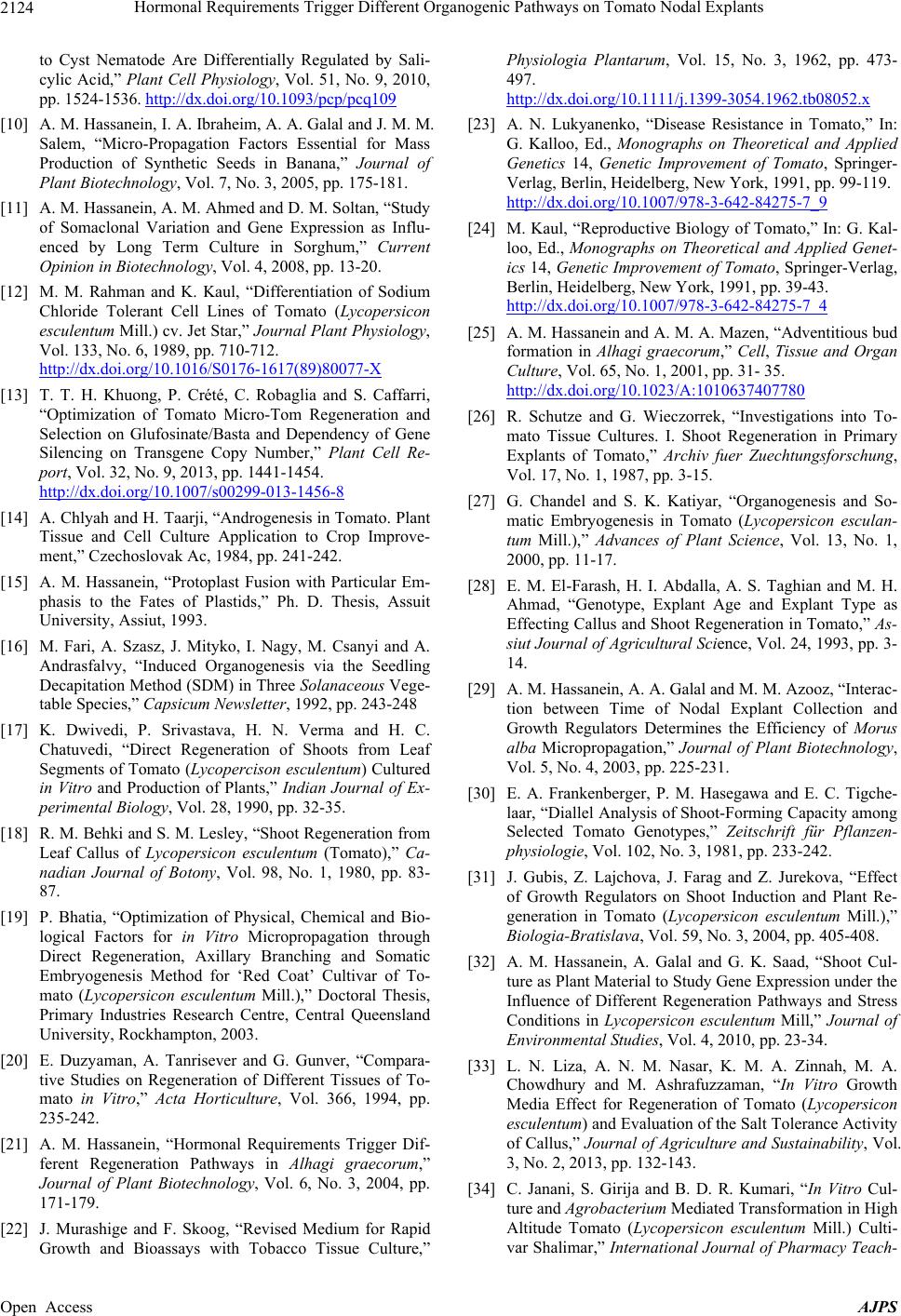
Hormonal Requirements Trigger Different Organogenic Pathways on Tomato Nodal Explants
2124
to Cyst Nematode Are Differentially Regulated by Sali-
cylic Acid,” Plant Cell Physiology, Vol. 51, No. 9, 2010,
pp. 1524-1536. http://dx.doi.org/10.1093/pcp/pcq109
[10] A. M. Hassanein, I. A. Ibraheim, A. A. Galal and J. M. M.
Salem, “Micro-Propagation Factors Essential for Mass
Production of Synthetic Seeds in Banana,” Journal of
Plant Biotechnology, Vol. 7, No. 3, 2005, pp. 175-181.
[11] A. M. Hassanein, A. M. Ahmed and D. M. Soltan, “Study
of Somaclonal Variation and Gene Expression as Influ-
enced by Long Term Culture in Sorghum,” Current
Opinion in Biotechnology, Vol. 4, 2008, pp. 13-20.
[12] M. M. Rahman and K. Kaul, “Differentiation of Sodium
Chloride Tolerant Cell Lines of Tomato (Lycopersicon
esculentum Mill.) cv. Jet Star,” Journal Plant Physiology,
Vol. 133, No. 6, 1989, pp. 710-712.
http://dx.doi.org/10.1016/S0176-1617(89)80077-X
[13] T. T. H. Khuong, P. Crété, C. Robaglia and S. Caffarri,
“Optimization of Tomato Micro-Tom Regeneration and
Selection on Glufosinate/Basta and Dependency of Gene
Silencing on Transgene Copy Number,” Plant Cell Re-
port, Vol. 32, No. 9, 2013, pp. 1441-1454.
http://dx.doi.org/10.1007/s00299-013-1456-8
[14] A. Chlyah and H. Taarji, “Androgenesis in Tomato. Plant
Tissue and Cell Culture Application to Crop Improve-
ment,” Czechoslovak Ac, 1984, pp. 241-242.
[15] A. M. Hassanein, “Protoplast Fusion with Particular Em-
phasis to the Fates of Plastids,” Ph. D. Thesis, Assuit
University, Assiut, 1993.
[16] M. Fari, A. Szasz, J. Mityko, I. Nagy, M. Csanyi and A.
Andrasfalvy, “Induced Organogenesis via the Seedling
Decapitation Method (SDM) in Three Solanaceous Vege-
table Species,” Capsicum Newsletter, 1992, pp. 243-248
[17] K. Dwivedi, P. Srivastava, H. N. Verma and H. C.
Chatuvedi, “Direct Regeneration of Shoots from Leaf
Segments of Tomato (Lycopercison esculentum) Cultured
in Vitro and Production of Plants,” Indian Journal of Ex-
perimental Biology, Vol. 28, 1990, pp. 32-35.
[18] R. M. Behki and S. M. Lesley, “Shoot Regeneration from
Leaf Callus of Lycopersicon esculentum (Tomato),” Ca-
nadian Journal of Botony, Vol. 98, No. 1, 1980, pp. 83-
87.
[19] P. Bhatia, “Optimization of Physical, Chemical and Bio-
logical Factors for in Vitro Micropropagation through
Direct Regeneration, Axillary Branching and Somatic
Embryogenesis Method for ‘Red Coat’ Cultivar of To-
mato (Lycopersicon esculentum Mill.),” Doctoral Thesis,
Primary Industries Research Centre, Central Queensland
University, Rockhampton, 2003.
[20] E. Duzyaman, A. Tanrisever and G. Gunver, “Compara-
tive Studies on Regeneration of Different Tissues of To-
mato in Vitro,” Acta Horticulture, Vol. 366, 1994, pp.
235-242.
[21] A. M. Hassanein, “Hormonal Requirements Trigger Dif-
ferent Regeneration Pathways in Alhagi graecorum,”
Journal of Plant Biotechnology, Vol. 6, No. 3, 2004, pp.
171-179.
[22] J. Murashige and F. Skoog, “Revised Medium for Rapid
Growth and Bioassays with Tobacco Tissue Culture,”
Physiologia Plantarum, Vol. 15, No. 3, 1962, pp. 473-
497.
http://dx.doi.org/10.1111/j.1399-3054.1962.tb08052.x
[23] A. N. Lukyanenko, “Disease Resistance in Tomato,” In:
G. Kalloo, Ed., Monographs on Theoretical and Applied
Genetics 14, Genetic Improvement of Tomato, Springer-
Verlag, Berlin, Heidelberg, New York, 1991, pp. 99-119.
http://dx.doi.org/10.1007/978-3-642-84275-7_9
[24] M. Kaul, “Reproductive Biology of Tomato,” In: G. Kal-
loo, Ed., Monographs on Theoretical and Applied Genet-
ics 14, Genetic Improvement of Tomato, Springer-Verlag,
Berlin, Heidelberg, New York, 1991, pp. 39-43.
http://dx.doi.org/10.1007/978-3-642-84275-7_4
[25] A. M. Hassanein and A. M. A. Mazen, “Adventitious bud
formation in Alhagi graecorum,” Cell, Tissue and Organ
Culture, Vol. 65, No. 1, 2001, pp. 31- 35.
http://dx.doi.org/10.1023/A:1010637407780
[26] R. Schutze and G. Wieczorrek, “Investigations into To-
mato Tissue Cultures. I. Shoot Regeneration in Primary
Explants of Tomato,” Archiv fuer Zuechtungsforschung,
Vol. 17, No. 1, 1987, pp. 3-15.
[27] G. Chandel and S. K. Katiyar, “Organogenesis and So-
matic Embryogenesis in Tomato (Lycopersicon esculan-
tum Mill.),” Advances of Plant Science, Vol. 13, No. 1,
2000, pp. 11-17.
[28] E. M. El-Farash, H. I. Abdalla, A. S. Taghian and M. H.
Ahmad, “Genotype, Explant Age and Explant Type as
Effecting Callus and Shoot Regeneration in Tomato,” As-
siut Journal of Agricultural Science, Vol. 24, 1993, pp. 3-
14.
[29] A. M. Hassanein, A. A. Galal and M. M. Azooz, “Interac-
tion between Time of Nodal Explant Collection and
Growth Regulators Determines the Efficiency of Morus
alba Micropropagation,” Journal of Plant Biotechnology,
Vol. 5, No. 4, 2003, pp. 225-231.
[30] E. A. Frankenberger, P. M. Hasegawa and E. C. Tigche-
laar, “Diallel Analysis of Shoot-Forming Capacity among
Selected Tomato Genotypes,” Zeitschrift für Pflanzen-
physiologie, Vol. 102, No. 3, 1981, pp. 233-242.
[31] J. Gubis, Z. Lajchova, J. Farag and Z. Jurekova, “Effect
of Growth Regulators on Shoot Induction and Plant Re-
generation in Tomato (Lycopersicon esculentum Mill.),”
Biologia-Bratislava, Vol. 59, No. 3, 2004, pp. 405-408.
[32] A. M. Hassanein, A. Galal and G. K. Saad, “Shoot Cul-
ture as Plant Material to Study Gene Expression under the
Influence of Different Regeneration Pathways and Stress
Conditions in Lycopersicon esculentum Mill,” Journal of
Environmental Studies, Vol. 4, 2010, pp. 23-34.
[33] L. N. Liza, A. N. M. Nasar, K. M. A. Zinnah, M. A.
Chowdhury and M. Ashrafuzzaman, “In Vitro Growth
Media Effect for Regeneration of Tomato (Lycopersicon
esculentum) and Evaluation of the Salt Tolerance Activity
of Callus,” Journal of Agriculture and Sustainability, Vol.
3, No. 2, 2013, pp. 132-143.
[34] C. Janani, S. Girija and B. D. R. Kumari, “In Vitro Cul-
ture and Agrobacterium Mediated Transformation in High
Altitude Tomato (Lycopersicon esculentum Mill.) Culti-
var Shalimar,” International Journal of Pharmacy Teach-
Open Access AJPS